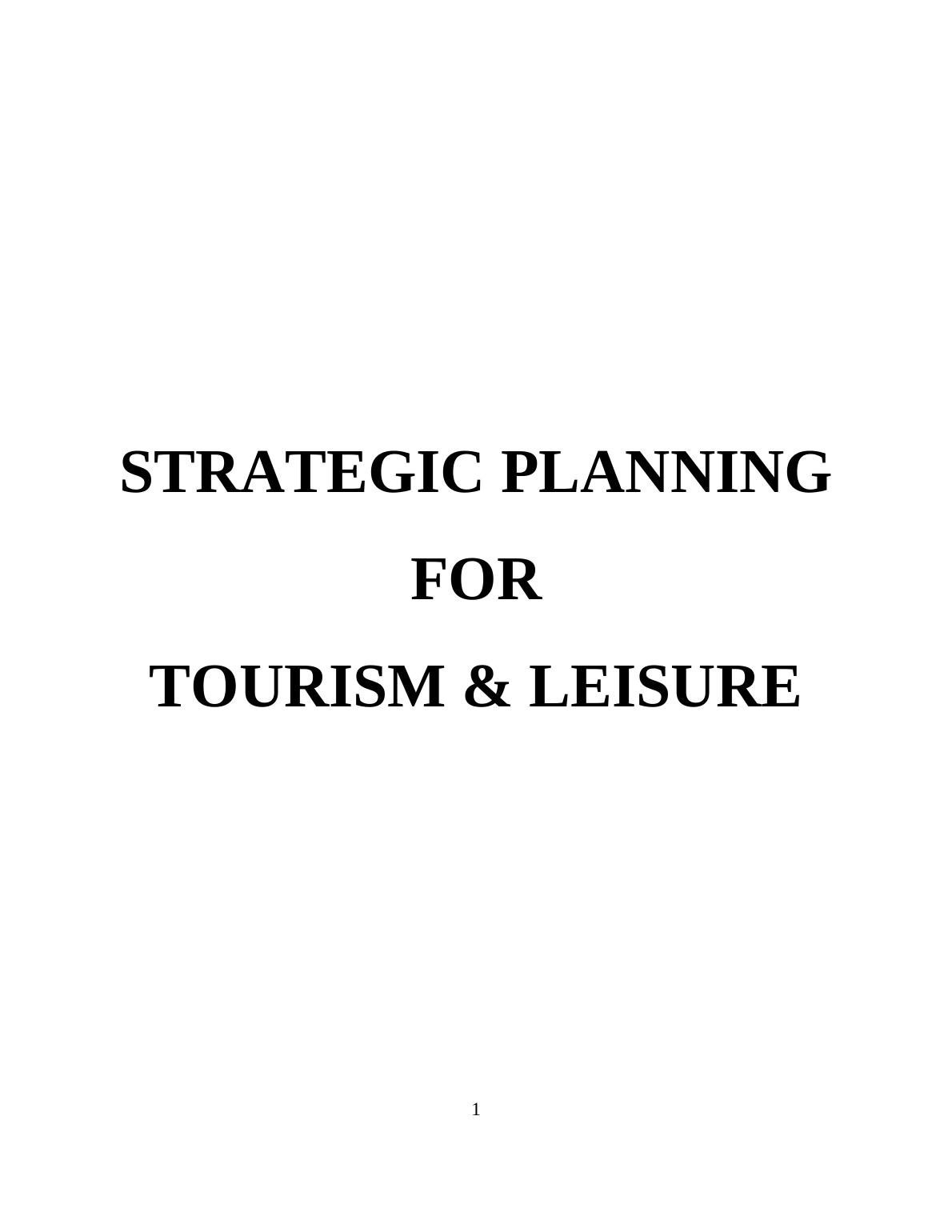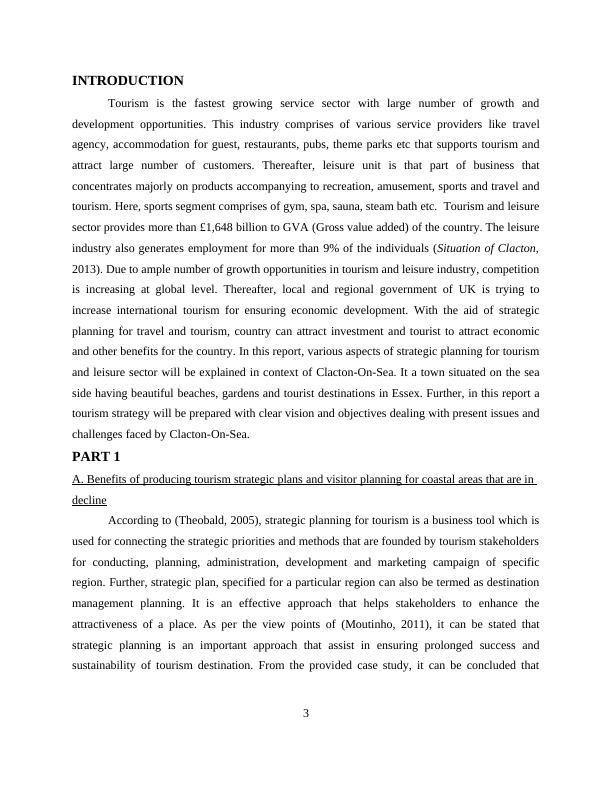strategic planning for tourism and leisure-2
Added on 2019-12-04
12 Pages4285 Words166 Views
STRATEGIC PLANNINGFOR TOURISM & LEISURE1

TABLE OF CONTENTSINTRODUCTION................................................................................................................................3PART 1.................................................................................................................................................3A. Benefits of producing tourism strategic plans and visitor planning for coastal areas that arein decline......................................................................................................................................3B. Current tourism situation of Clacton-On-Sea taking into consideration present tourismstrategies and visitor planing.......................................................................................................5PART 2.................................................................................................................................................7C Tourism strategy with clear vision and objectives...................................................................7D Implementation of vision and objectives along with indemnification of key stakeholders.....8E. Describing how the strategy is going to benefit the residents and nearby visitors andhandling the issue of Severe social breakdown...........................................................................9CONCLUSION..................................................................................................................................10REFERENCES...................................................................................................................................112

INTRODUCTIONTourism is the fastest growing service sector with large number of growth anddevelopment opportunities. This industry comprises of various service providers like travelagency, accommodation for guest, restaurants, pubs, theme parks etc that supports tourism andattract large number of customers. Thereafter, leisure unit is that part of business thatconcentrates majorly on products accompanying to recreation, amusement, sports and travel andtourism. Here, sports segment comprises of gym, spa, sauna, steam bath etc. Tourism and leisuresector provides more than £1,648 billion to GVA (Gross value added) of the country. The leisureindustry also generates employment for more than 9% of the individuals (Situation of Clacton,2013). Due to ample number of growth opportunities in tourism and leisure industry, competitionis increasing at global level. Thereafter, local and regional government of UK is trying toincrease international tourism for ensuring economic development. With the aid of strategicplanning for travel and tourism, country can attract investment and tourist to attract economicand other benefits for the country. In this report, various aspects of strategic planning for tourismand leisure sector will be explained in context of Clacton-On-Sea. It a town situated on the seaside having beautiful beaches, gardens and tourist destinations in Essex. Further, in this report atourism strategy will be prepared with clear vision and objectives dealing with present issues andchallenges faced by Clacton-On-Sea. PART 1 A. Benefits of producing tourism strategic plans and visitor planning for coastal areas that are in declineAccording to (Theobald, 2005), strategic planning for tourism is a business tool which isused for connecting the strategic priorities and methods that are founded by tourism stakeholdersfor conducting, planning, administration, development and marketing campaign of specificregion. Further, strategic plan, specified for a particular region can also be termed as destinationmanagement planning. It is an effective approach that helps stakeholders to enhance theattractiveness of a place. As per the view points of (Moutinho, 2011), it can be stated thatstrategic planning is an important approach that assist in ensuring prolonged success andsustainability of tourism destination. From the provided case study, it can be concluded that3

Clacton-On-Sea is facing a serious downfall in tourism. It is one of the biggest towns situated onEssex Sunshine Coast. Since 1970s, the destination is facing issues of cheaper tourism resultinginto depletion of economy. It has been critically analyzed by (Pigram and Wahab, 2005) thatClacton-On-Sea is also facing issues of increasing poverty in region leading to breakdown offamilies. In addition to this, the region have low skilled workforce leading to poor serviceperformance. All this aspects are declining the desirability of place in the mind set of tourists.However, with the aid of strategic planning, the regional government of Clacton can takeeffective measures to re-innovate the city and boost international and domestic tourism (Matias,Nijkamp and Sarmento, 2012). It will further help in injecting money into the economy andresolving the problems of poverty, unemployment and depletion of economy. Furthermore, thereare large numbers of benefits of strategic planning in promoting tourism for the coastal areas thatleads to decline in tourism. The explanation of which are as follows: Improved focus on vision: As per the view point of (Page, 2014) tourism strategic planwill help in focusing on vision of tourism stakeholders. It will further help in developingbroader perspective and give an overall direction to the strategic actions. In this respect,vision statement of region states that, Clacton-On-Sea is an attractive travel destinationthat aim at fulfilling leisure, tourism and hospitality needs of visitors and ensure theconstant up-gradation in living standards of the local population. Setting Targets: It will also help stakeholders of tourism in setting targets so that theymeet them through strategic planning (Novelli, Schmitz and Spencer, 2006). With thisaspect, Clacton can determine the targets like, increase in visitor’s expenditure,modification in the quality of services, increase in international tourism. It can alsoinvolve factors like, enhancement of duration of stay of visitors and their repetitive visitto Clacton-On-Sea. Quantitative targets: To ensure success of strategic plan, administrators of cited city candetermine quantitative targets. Therefore, stakeholders can become properly involved inmeeting the targets and ensure attainment of mutual effort. For instance, regionalgovernment can set target for their strategic plan like, to maximize the income fromtourism of Clacton-On-Sea by 5% in real terms in 2016 or increase the visitor’sexpenditure by 8% (Situation of Clacton, 2013). 4

End of preview
Want to access all the pages? Upload your documents or become a member.
Related Documents
Strategic Planning for Tourism and Leisure: Doclg...
|12
|3824
|423
Strategic Planning in Tourism Sectorlg...
|14
|5177
|238
Benefits of Producing Tourism Strategic Planslg...
|12
|4280
|2081
Strategic Planning for Tourism Development in Deal: Collaborative Planning and Recovery from Covid-19lg...
|13
|5023
|431
Tourism Strategic Planning and Collaborative Planning for Deal Coastal Arealg...
|16
|5189
|63
TLH302 - Strategic Planning for Tourism and Leisurelg...
|19
|5468
|150
